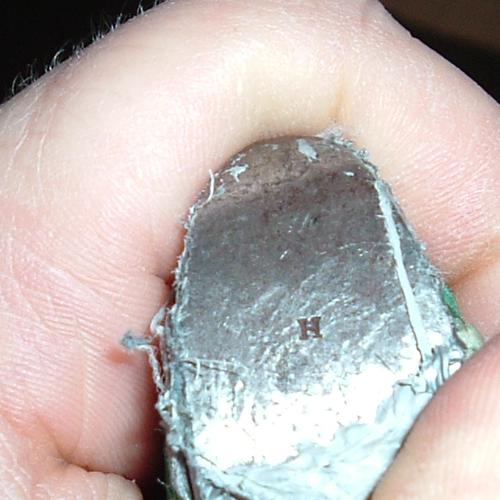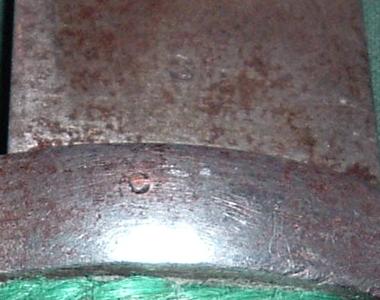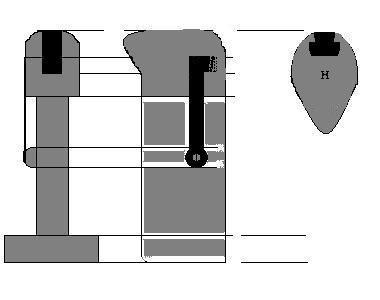Posts: 63 Location: New Hampshire, USA
Thu 13 Apr, 2006 7:57 am
Identifying a Sword Bayonet
Posts: 1,563 Location: Upstate NY
Thu 13 Apr, 2006 8:08 am
That I know of there were bayonettes of this recurve shape made by firms in both England and France. A small quantity of Enfield muskets with bayonettes of this type were imported during the Civil War in the states. The French type was for I believe the Chassepot (sp) rifle if memory serves. Can't tell you which country its from, i'm not that up on bayonettes.
Posts: 9,545 Location: Dayton, OH
Thu 13 Apr, 2006 9:01 am
The sword bayonet for the British Enfield Artillery carbine of 1856 has a similar guard and blade. It's hard to tell what the grip and pommel look like with that re-wrap yours has. The Enfield bayonet would have had checkered slabs on the tang with three rivets.
The sword bayonet for the 1866 French Chassepot rifle also had a similar blade and guard, though the fuller on yours looks closer to the British version.
Posts: 63 Location: New Hampshire, USA
Thu 13 Apr, 2006 9:20 am
Now that's just weird because I don't think that mine has any rivet-holes going through the tang. Although now that I think about I think it does have three rivet holes . . .
Last edited by Korey J. Lavoie on Thu 13 Apr, 2006 4:11 pm; edited 2 times in total
Posts: 30 Location: Salisbury, Maryland
Thu 13 Apr, 2006 10:40 am
I have a very similar Sword Bayonet that I bought at a local army/navy store for $45. It has an inscription on the top of the back-ridge near the guard. It's French, and bares the year 1873, as well as having the number 2 stamped on the side of the blade. The one-piece grip and pommel on mine is cast brass, and the tang is very noticably peened through the top of the pommel. One interesting thing I've noticed about mine is that the blade is hollow; I can hear things moving around inside it when it is inverted.
Compared to yours, one difference I see is that the fuller on mine runs all the way up to about a quater of an inch from the guard, getting wider on the way. Another one is that mine has either a rivet or bolt (too rusty to see) closing the loop around where the barrel would go through. Also, my grip/pommel has a total of 5 rivets. The largest comes out from the left side of the pommel (when held in the hand). The remaining 4 are on the grip; 2 on the left and 2 on the right.
I almost forgot, mine has an all-iron scabbard with very feint diamond and S shapped patterns on it. I'd be interested in knowing if your has a scabbard as well.
Posts: 63 Location: New Hampshire, USA
Thu 13 Apr, 2006 12:44 pm
The hollow blade is a very unusual feature, can you tell how it was made? As in was it cast, or forged hollow. I'll go out on a limb and guess that it was made hollow in an attempt to keep the weight of the weapon down.
I have no idea if mine had a scabbard but logically it must have had one of some form.
Posts: 9,545 Location: Dayton, OH
Thu 13 Apr, 2006 1:10 pm
| Korey J. Lavoie wrote: |
The hollow blade is a very unusual feature, can you tell how it was made? As in was it cast, or forged hollow. I'll go out on a limb and guess that it was made hollow in an attempt to keep the weight of the weapon down.
I have no idea if mine had a scabbard but logically it must have had one of some form. |
Korey,
The hollowed area is called a fuller. It would have been forged in out ground in. This article goes into fullers a bit. Fullers lighten the blade without comprosing strength too much.
Steel blades of any quality were not cast. They would have been forged out or ground down from stock. See here for more info.
Do you have any pics of the bayonet without the grip re-wrap? That may help folks decide what it is or isn't. Pommel shape, tang shape, etc. can aid in identification.
If I had to guess, I'd say the one Cory mentions is French because its fuller widens at the base and runs close to the guard like a pic of the Chassepot bayonet I saw. Korey's blade however, looks more like the Enfield version. Both are yataghan-style blades.
Of course, I'm far from a bayonet expert. I just happen to have some good books with good pictures. :)
Posts: 9,545 Location: Dayton, OH
Thu 13 Apr, 2006 1:36 pm
Posts: 63 Location: New Hampshire, USA
Thu 13 Apr, 2006 2:08 pm
| Chad Arnow wrote: |
| Korey J. Lavoie wrote: | The hollow blade is a very unusual feature, can you tell how it was made? As in was it cast, or forged hollow. I'll go out on a limb and guess that it was made hollow in an attempt to keep the weight of the weapon down.
I have no idea if mine had a scabbard but logically it must have had one of some form. |
Korey,
The hollowed area is called a fuller. It would have been forged in out ground in. This article goes into fullers a bit. Fullers lighten the blade without comprosing strength too much.
Steel blades of any quality were not cast. They would have been forged out or ground down from stock. See here for more info.
Do you have any pics of the bayonet without the grip re-wrap? That may help folks decide what it is or isn't. Pommel shape, tang shape, etc. can aid in identification.
If I had to guess, I'd say the one Cory mentions is French because its fuller widens at the base and runs close to the guard like a pic of the Chassepot bayonet I saw. Korey's blade however, looks more like the Enfield version. Both are yataghan-style blades.
Of course, I'm far from a bayonet expert. I just happen to have some good books with good pictures. :) |
I do know what a fuller is, Cory is obviously referring to something else though: | Quote: |
| One interesting thing I've noticed about mine is that the blade is hollow; I can hear things moving around inside it when it is inverted. |
Although in retrospect I will concede that it probably isn't cast.
Looking at the features of the images you posted gives me the impression that my Bayonet looks like a hybrid of the two, the MS Paint diagram that I made is an accurate representation of what the handle of my Bayonet looks like with only minor inaccuracies in terms of scale. However, I should have time this week to strip off the wrap. Thanks for the images, It's very provocative and I'm thinking that I have something truly rare on my hands.
Posts: 30 Location: Salisbury, Maryland
Thu 13 Apr, 2006 2:11 pm
| Russ Ellis wrote: |
| Chad Arnow wrote: |
Korey,
The hollowed area is called a fuller. It would have been forged in out ground in. |
It doesn't sound like Korey is talking about a hollowed out area but rather that the blade as an internal cavity... which would be a rather odd feature to say the least. Korey are you sure that it is something rattling around inside the blade and not in the hilt or the handle? |
I'm %100 sure that the blade is hollow at least to some degree. It may only be the back ridge on the opposite side of the fuller than the edge that is hollow, but something (presumably a few pieces of loose oxidation) slides abou 8 inches up and down the inside of the blade. The grip/pommel and guard are rock solid.
Chad:
You have correctly identified my Bayonet as the Chassepot pictured at the bottom of your last post. Do you know how long they were in production, since mine was inscribed with the year 1873?
Posts: 9,545 Location: Dayton, OH
Thu 13 Apr, 2006 2:23 pm
| Cory Winslow wrote: |
I'm %100 sure that the blade is hollow at least to some degree. It may only be the back ridge on the opposite side of the fuller than the edge that is hollow, but something (presumably a few pieces of loose oxidation) slides abour 8 inches up and down the inside of the blade. The grip/pommel and guard are rock solid.
Chad:
You have correctly identified my Bayonet as the Chassepot pictured at the bottom of your last post. Do you know how long they were in production, since mine was inscribed with the year 1873? |
Corey,
Glad I could help even though bayonets are a few hundred years late for my taste. :) The Gras rifle replaced the Chassepot in 1874 and had a new bayonet. So yours should be from the last full year of the Chassepot if it's French.
According to some googling, though, Remington made a Chassepot-style bayonet. If yours says "Belgium" on the pommel, it may be a Remington. If it has writing on the spine in French with a date, it's likely French. :)
As for the blade being hollow, that's odd.
You
cannot post new topics in this forum
You
cannot reply to topics in this forum
You
cannot edit your posts in this forum
You
cannot delete your posts in this forum
You
cannot vote in polls in this forum
You
cannot attach files in this forum
You
can download files in this forum







